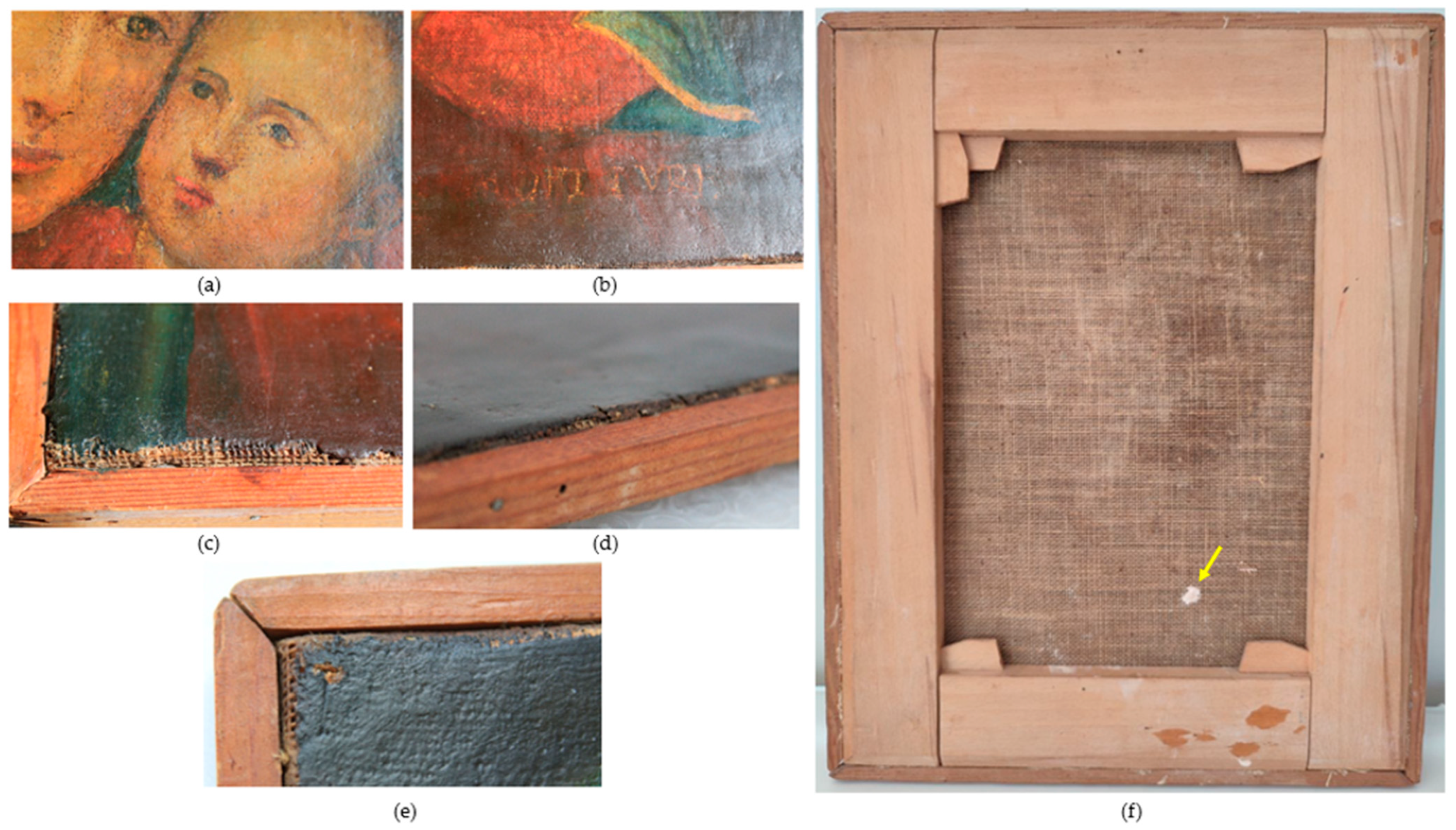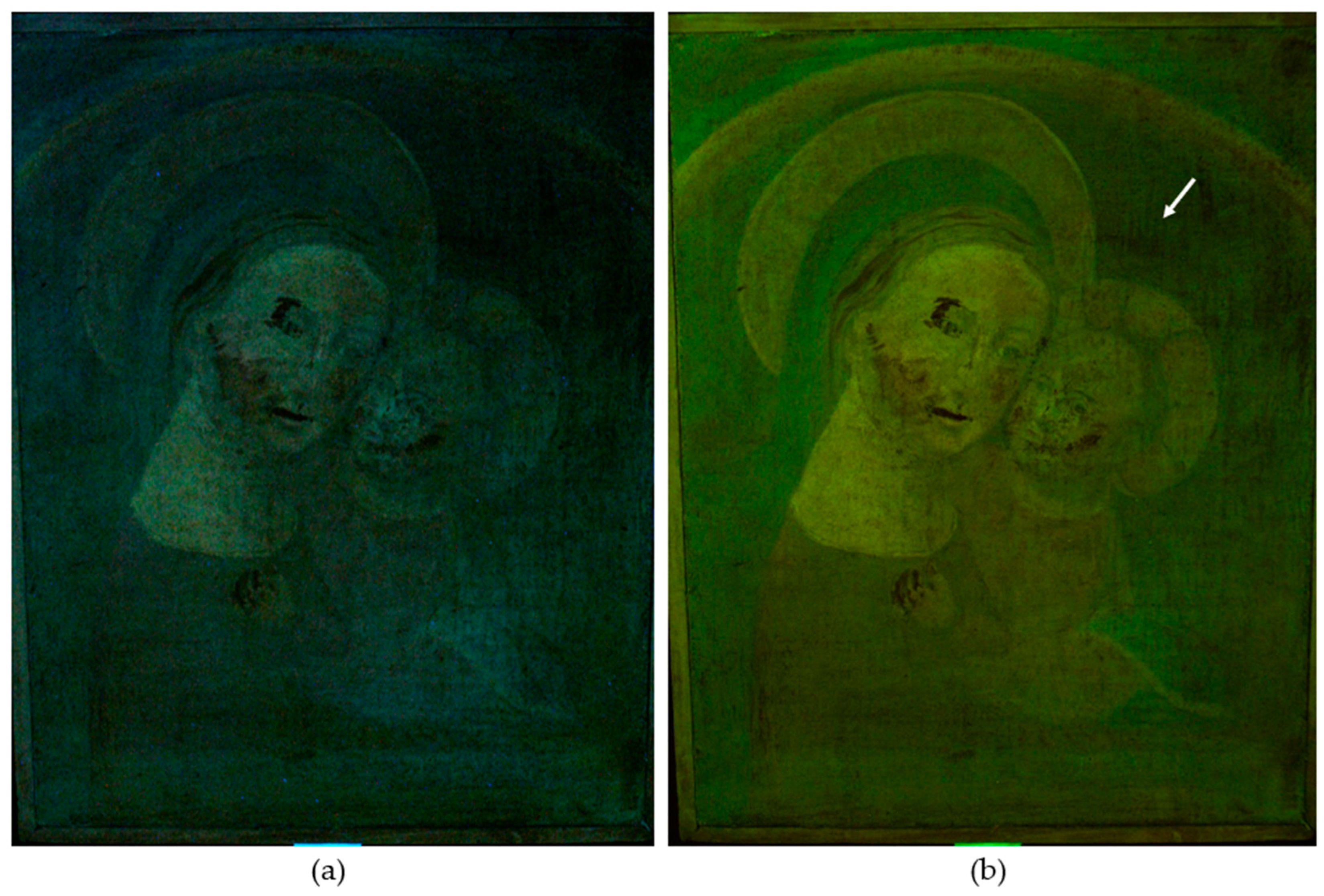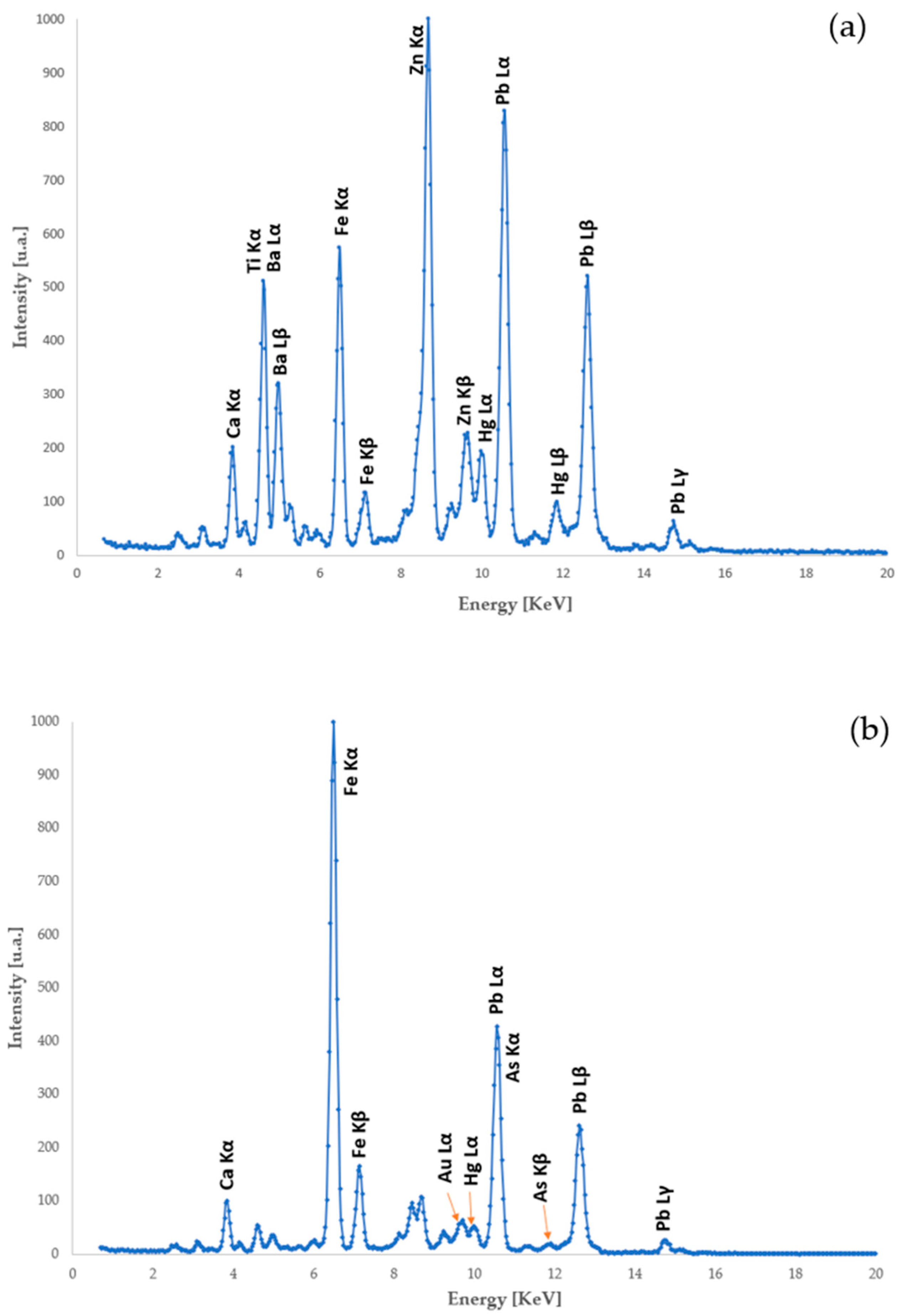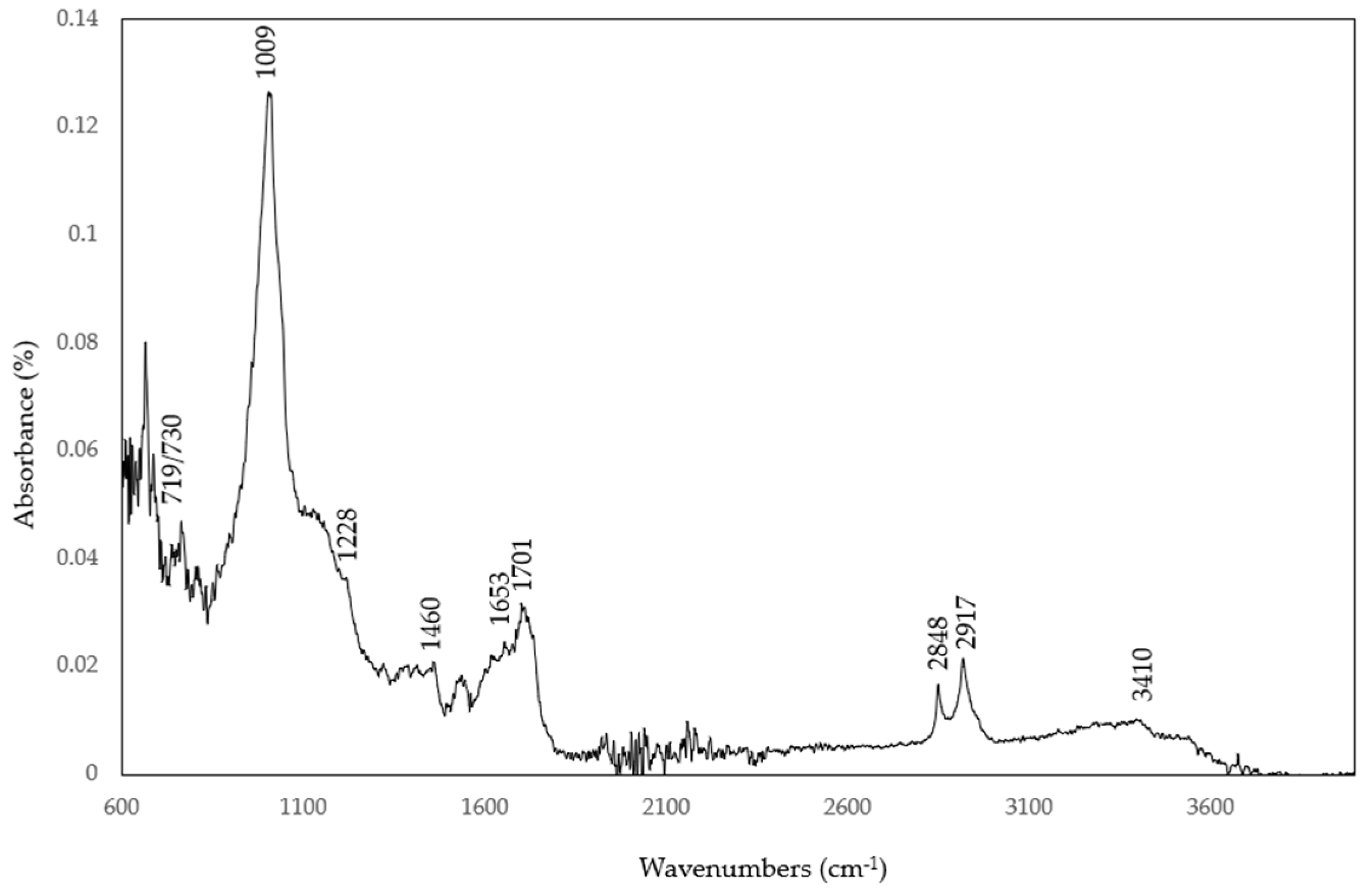Multianalytical Non-Invasive Characterization of ‘Mater Boni Consilii’ Iconography Oil Painting
Abstract
1. Introduction
2. Materials and Methods
3. Results
3.1. Preliminary Observations by Visual Analysis
3.2. Multispectral Imaging
3.3. Elemental Analyses of Pictorial Layers (ED-XRF)
3.4. FTIR-ATR Spectroscopy
 (Si-O-Si)™ and (Si-O-Al), probably linked with the constitutive units of the lazurite [27], which is the main component of the ornamental stone from which the ultramarine blue pigment is produced. The absence of the typical bands related to the asymmetric stretching of the C≡N group at ~2090 cm−1, in agreement with the IRUG database [28,29], allows us to exclude the use of the Prussian Blue, a pigment composed of ferric ferrocyanide (Fe4[Fe(CN)6]·nH2O). From those data, we assume the use of ultramarine blue (Na8Al6Si6O24S4), for the realization of the background.
(Si-O-Si)™ and (Si-O-Al), probably linked with the constitutive units of the lazurite [27], which is the main component of the ornamental stone from which the ultramarine blue pigment is produced. The absence of the typical bands related to the asymmetric stretching of the C≡N group at ~2090 cm−1, in agreement with the IRUG database [28,29], allows us to exclude the use of the Prussian Blue, a pigment composed of ferric ferrocyanide (Fe4[Fe(CN)6]·nH2O). From those data, we assume the use of ultramarine blue (Na8Al6Si6O24S4), for the realization of the background.4. Discussion
5. Conclusions
Author Contributions
Funding
Data Availability Statement
Conflicts of Interest
References
- Delbianco, V. La Madonna del Buon Consiglio. Storia e Fortuna di Un’iconografia Mariana. Il Caso del Trentino. 2016. Available online: https://www.academia.edu (accessed on 4 October 2022).
- De Orgio, A.M. Istoriche Notizie Della Prodigiosa Apparizione Dell’immagine di Maria Santissima del Buon Consiglio Nella Chiesa de’Padri Agostiniani di Genazzano; Stamperia di S. Michele per Ottavio Puccinelli: Rome, Italy, 1748. [Google Scholar]
- BeWeB-Beni Ecclesiastici in Web CEI-Ufficio Nazionale per i Beni Culturali Ecclesiastici e L’edilizia di Culto. Available online: https://www.beweb.chiesacattolica.it/UI/page.jsp?action=ricerca%2Frisultati&view=griglia&locale=it&ordine=&ambito=CEIOA&liberadescr=Madonna+del+Buon+consiglio&liberaluogo=Firenze (accessed on 4 October 2022).
- Pelagotti, A.; Del Mastio, A.; De Rosa, A.; Piva, A. Multispectral imaging of paintings. IEEE Signal Process. Mag. 2008, 25, 27–36. [Google Scholar] [CrossRef]
- Pelagotti, A.; Pezzati, L.; Bevilacqua, N.; Vascotto, V.; Reillon, V.; Daffara, C. A Study of UV Fluorescence Emission of Painting Materials. In Proceedings of the 8th International Conference on Non-Destructive Testing and Microanalysis for the Diagnostics and Conservation of the Cultural and Environmental Heritage, Lecce, Italy, 15–19 May 2005. [Google Scholar]
- Macovaz, V. Indagini e diagnostica fotografica per i Beni Culturali. In Relazione Tecnica; Diagnostica per i BBCC: Trieste, Italy, 2016. [Google Scholar]
- Bitossi, G.; Giorgi, R.; Mauro, M.; Salvadori, B.; Dei, L. Spectroscopic Techniques in Cultural Heritage Conservation: A Survey. Appl. Spectrosc. Rev. 2005, 40, 187–228. [Google Scholar] [CrossRef]
- Macchia, A.; Aureli, H.; Colasanti, I.A.; Rivaroli, L.; Tarquini, O.; Sabatini, M.; Dattanasio, M.; Pantoja Munoz, L.; Colapietro, M.; La Russa, M.F. IN SITU DIAGNOSTIC ANALYSIS OF THE SECOND HALF OF XVIII CENTURY “MORTE DI SANT’ORSOLA” PANEL PAINTING COMING FROM CHIESA DEI SANTI LEONARDO E ERASMO ROCCAGORGA (LT, ITALY). Int. J. Conserv. Sci. 2021, 12, 1377–1390. [Google Scholar]
- Saladino, M.L.; Ridolfi, S.; Carocci, I.; Martino, D.C.; Lombardo, R.; Spinella, A.; Traina, G.; Caponetti, E. A multianalytical non-invasive and micro-invasive approach to canvas oil paintings. General considerations from a specific case. Microchem. J. 2017, 133, 607–613. [Google Scholar] [CrossRef]
- Bottoli, A.; Marchiafava, V. Colore e Colorimetria. Contributi Multidisciplinari. Vol. XV A.; Gruppo del Colore—Associazione Italiana Colore: Milan, Italy, 2019. [Google Scholar]
- Bevilacqua, N.; Borgioli, L.; Adrover, G.I. I Pigmenti Nell’arte. Dalla Preistoria Alla Rivoluzione Industriale; Il Prato: Nikko, Japan, 2019. [Google Scholar]
- Seccaroni, C.; Moioli, P. Fluorescenza X. Prontuario per L’analisi XRF Portatile Applica a Superfici Policrome; Nardini Editore: Florence, Italy, 2004. [Google Scholar]
- Mailunas, R.J.; Bensten, J.G.; Steinberg, A. Analysis of aged paint binders by FTIR Spectroscopy. Stud. Conserv. 1990, 35, 33–51. [Google Scholar]
- Silverstein, R.M.; Webster, F.X.; Kiemle, D.J. Identificazione Spettrometrica di Composti Organici. Casa Editrice Ambrosiana Distribuzione Esclusiva Zanichelli; Wiley: Hoboken, NJ, USA, 2016. [Google Scholar]
- Solé, V.A.; Papillon, E.; Cotte, M.; Walter, P.; Susini, J. A multiplatform code for the analysis of energy-dispersive X-ray fluorescence spectra. Spectrochim. Acta Part B 2007, 62, 63–68. [Google Scholar] [CrossRef]
- ColourLex. Available online: https://colourlex.com/ (accessed on 5 November 2022).
- Longoni, M.; Cacciola, E.S.; Bruni, S. UV-Excited Fluorescence as a Basis for the In-Situ Identification of Natural Binders in Historical Painting: A critical Study on Model Samples. Chemosensors 2022, 10, 256. [Google Scholar] [CrossRef]
- Derrick, M.; Stilik, D.; Landry, J.M. Infrared Spectroscopy in Conservation Science (Scientific Tools for Conservation); The Getty Conservation Institute: Los Angeles, CA, USA, 1999. [Google Scholar]
- Raïch, M.; Artoni, P.; Herrero, M.A.; La Bella, A.; Ricci, M.L.; Hernàndez, A. Riconoscere dal colore. Pigmenti e coloranti dell’età moderna nell’analisi multibanda dei dipinti: Uno strumento visivo per gli storici dell’arte e i conservatori. In Colore e Colorimetria. Contributi Multidisciplinari; Bottoli, A., Marchiafava, V., Eds.; Gruppo del Colore-Associazione Italiana del Colore: Milano, Italy, 2019; Volume XV, pp. 120–127. [Google Scholar]
- Daffara, C.; Fontana, R. Multispectral Infrared Reflectography to Differentiate Features in Paintings. Microsc. Microanal. 2011, 17, 691–695. [Google Scholar] [CrossRef]
- Poldi, G.; Villa, G.C.F. Dalla Conservazione Alla Storia Dell’arte-Riflettografia e Analisi non Invasive per lo Studio dei Dipinti; Edizioni Della Normale: Pisa, Italy, 2006; pp. 91–97. [Google Scholar]
- Lorusso, S.; Vandini, M.; Matteucci, C.; Tumidei, S.; Campanella, L. Anamnesi storica ed indagine diagnostica del dipinto ad olio su tavola “Madonna con bambino e Santi Girolamano e Caterina da Siena” attribuibile a Domenica Baccafumi (1486–1551). Quad. Di Sci. Della Conserv. 2003, 47–68. [Google Scholar]
- Hradil, D.; Grygar, T.; Hradilová, J.; BezdičKa, P. Clay and iron oxide pigments in the history of painting. Appl. Clay Sci. 2003, 22, 223–236. [Google Scholar] [CrossRef]
- Picollo, M.; Bacci, M.; Magrini, D.; Radicati, B.; Trumpy, G.; Tsukada, M.; Kunzelman, D. Modern White Pigment: Their Identification By Means of Noninvasive Ultraviolet, Visible, and Infrared Fiber Optic Reflectance Spectroscopy. In Modern Paints Uncovered: Proceedings from the Modern Paints Uncovered Symposium, Tate Modern, London, UK, 16–19 May 2006; Learner, T.J.S., Smithen, P., Krueger, J.W., Schilling, M.R., Eds.; Getty Conservation Institute: London, UK, 2006; pp. 118–128. [Google Scholar]
- Bracci, S.; Giachi, G.; Liverani, P.; Pallecchi, P.; Paolucci, F. Polychromy in Ancient Sculpture and Architecture; Casa Editrice Sillabe S.r.l.: Livorno, Italy, 2018. [Google Scholar]
- Pronti, L.; Felici, A.C.; Ménager, M.; Vieillescazes, C.; Piacentini, M. Spectral Behavior of White Pigment Mixtures Using Reflectance, Ultraviolet-Fluorescence Spectroscopy, and Multispectral Imaging. Appl. Spectrosc. 2017, 71, 2616–2625. [Google Scholar] [CrossRef]
- Gettens, R.J.; Kühn, H.; Chase, W.T. Lead White. In Artists’ Pigments. A Handbook of Their History and Characteristics; Roy, A., Ed.; Oxford University Press: London, UK, 1993; Volume 2. [Google Scholar]
- Infrared and Raman Users Group Spectral Database (IRUG Database). Available online: www.irug.org (accessed on 13 December 2022).
- Rampazzi, L.; Brunello, V.; Corti, C.; Lissoni, E. Non-invasive techniques for revealing the palette of the Romantic painter Francesco Hayez. Spectrochim. Acta Part A Mol. Biomol. Spectrosc. 2017, 176, 142–154. [Google Scholar] [CrossRef]
- Derry, J. Investigationg Shellac: Documenting the Process, Defining the Product: A Study on the Processiong Methods of Shellac, and the Analysis of Selected Physical and Chemical Characteristics; The Institute of Archeology, Conservation and History: Oslo, Norway, 2012. [Google Scholar]
- Masae, M.; Pitsuwan, P.; Sikong, L.; Kooptarnond, K.; Kongsong, P.; Phoempoon, P. Termo-physical characterization of paraffin and beeswax on cotton fabric. Thammasat Int. J. Sci. Technol. 2014, 19, 69–77. [Google Scholar]
- Svečnjak, L.; Baranović, G.; Vinceković, M.; Prđun, S.; Bubalo, D.; Gajger, I.T. An approach for routine analytical detection of beeswax adulteration using ftir-atr spectroscopy. J. Apic. Sci. 2015, 59, 37–49. [Google Scholar] [CrossRef]
- Hepburn, H.R. Composition and Synthesis of Beeswax. In Honeybees and Wax; Springer: Berlin/Heidelberg, Germany, 1986; pp. 44–56. [Google Scholar]
- Macchia, A.; Biribicchi, C.; Carnazza, P.; Montorsi, S.; Sangiorgi, N.; Demasi, G.; Prestileo, F.; Cerafogli, E.; Colasanti, I.A.; Aureli, H.; et al. Multi-Analytical Investigation of the Oil Painting “Il Venditore di Cerini” by Antonio Mancini and Definition of the Best Green Cleaning Treatment. Sustainability 2022, 14, 3972. [Google Scholar] [CrossRef]
- Obradovic, J.; Petibon, F.; Fardim, P. Preparation and Characterisation of Cellulose-Shellac Biocomposites. BioResources 2017, 12, 1943–1959. [Google Scholar] [CrossRef]
- Abdel-Ghani, M. Dating a Coptic Icon of Anonymous Painter by Spectroscopic Study of Pigment Palette. Mediterr. Archaeol. Archaeom. 2015, 15, 23–37. [Google Scholar]
- Sarkar, P.C.; Kumar, K.K. An investigation into the different forms of lac resin using FT-IR and diffuse reflectance spectroscopy. Pigment. Resin Technol. 2001, 30, 25–33. [Google Scholar] [CrossRef]
- Guttens, R.J.; Stout, G.L. Painting Materials: A Short Encyclopedia; Dover Publications: Mineola, NY, USA, 1966; pp. 31–35. [Google Scholar]
- Bacci, M.; Picollo, M.; Trumpy, G.; Tsukada, M.; Kunzelman, D. Non-Invasive Identification of White Pigments on 20th Century Oil Piantings by Using Fiber Optic Reflectance Spectroscopy. J. Am. Inst. Conserv. 2007, 46, 27–37. [Google Scholar] [CrossRef]
- Brunner, H. Pitture. In Storia Della Tecnologia; Singer, C., Holmyard, A.J., Hall, A.R., Williams, T., Eds.; Bollati Boringhieri: Turin, Italy, 1982; Volume 6, pp. 617–631. [Google Scholar]
- Laver, M. Titanium white. In Artists’ Pigments: A Handbook of Their History and Characteristics; West FitzHugh, E., Ed.; National gallery of Art, Archetype Publications: London, UK, 1997; Volume 3, pp. 295–355. [Google Scholar]
- Van Driel, B.A. White, Friends or Foe? Understanding and Predicting Photocatalytic Degradation of Modern Oil Paintings; Delft University of Technology: Delft, The Netherlands, 2018. [Google Scholar] [CrossRef]
- Barnett, J.R.; Miller, S.; Pearce, E. Colour and art: A brief history of pigments. Opt. Laser Technol. 2006, 38, 445–453. [Google Scholar] [CrossRef]
- Osticioli, I.; Mendes, N.F.C.; Nervin, A.; Gil, F.P.S.C.; Becucci, M.; Castellucci, E. Analysis of natural and artificial ultramarine blue pigments using laser induced beakdown and pulsed Raman spectroscopy, statistical analysis a light microscopy. Spectrochim. Acta Part A 2009, 73, 525–531. [Google Scholar] [CrossRef] [PubMed]
- Miguel, C.; Pinto, J.V.; Clarke, M.; Melo, M.J. The alchemy of red mercury sulphide: The production of vermilion for medieval art. Dyes Pigment. 2014, 102, 210–217. [Google Scholar] [CrossRef]
- Gettens, R.J.; Feller, R.L.; Chase, W.T. Vermilion and Cinnabar. Stud. Conserv. 1972, 17, 45–69. [Google Scholar]
- Nöller, R. Cinnabar reviewed: Characterization of red pigment and its reactions. Stud. Conserv. 2013, 60, 79–87. [Google Scholar] [CrossRef]
- Edwards, H.G.M. Historical Pigments: A Survey of Analytical Chemical Archaemetric Usage and Terminology for Forensic Art Analysis. In Encyclopedia of Analytical Chemistry: Applications, Theory and Instrumentation; Wiley: Hoboken, NJ, USA, 2015. [Google Scholar] [CrossRef]









| Spot | Description | K [K] | Ca [K] | Ti [K] | Mn [K] | Fe [K] | Co [K] | Cu [L] | Zn [K] | As [K] | Sr [K] | Ba [L] | Au [L] | Hg [L] | Pb [L] |
|---|---|---|---|---|---|---|---|---|---|---|---|---|---|---|---|
| 1 | Neck incarnate of Madonna | 3.6 ± 0.2 | 4.4 ± 0.5 | 22.2 ± 0.4 | 1.6 ± 0.1 | 30.0 ± 0.5 | 0.3 ± 0.1 | 20.5 ± 0.6 | 17.4 ± 0.4 | ||||||
| 2 | Face incarnate of Madonna | 12.0 ± 0.3 | 4.4 ± 0.6 | 8.3 ± 0.3 | 2.0 ± 0.2 | 40.5 ± 0.6 | 0.8 ± 0.1 | 28.0 ± 0.7 | 4.0 ± 0.2 | ||||||
| 3 | Cheeks incarnate of Madonna | 4.0 ± 0.2 | 3.6 ± 0.4 | 12.8 ± 0.3 | 1.7 ± 0.1 | 21.3 ± 0.4 | 14.7 ± 0.5 | 6.6 ± 0.3 | 35.3 ± 0.5 | ||||||
| 4 | Madonna’s lips | 30.5 ± 0.7 | 2.5 ± 0.6 | 0.8 ± 0.2 | 18.5 ± 0.5 | 5.1 ± 0.3 | 20.0 ± 0.6 | 0.5 ± 0.2 | 14.6 ± 0.8 | 0.8 ± 0.3 | 6.7 ± 0.4 | ||||
| 5 | Child’s lips | 0.3 ± 0.1 | 3.3 ± 0.1 | 0.2 ± 0.1 | 1.3 ± 0.1 | 65.8 ± 0.6 | 2.0 ± 0.1 | 0.5 ± 0.1 | 1.0 ± 0.2 | 11.4 ± 0.3 | 14.5 ± 0.3 | ||||
| 6 | Face incarnate of Child | 8.1 ± 0.2 | 3.3 ± 0.4 | 16.1 ± 0.3 | 1.6 ± 0.1 | 28.3 ± 0.5 | 0.4 ± 0.1 | 20.9 ± 0.6 | 21.4 ± 0.4 | ||||||
| 7 | Child’s dress | traces | 9.1 ± 0.3 | 0.7 ± 0.2 | 0.7 ± 0.1 | 41.6 ± 0.6 | 2.2 ± 0.2 | 5.4 ± 0.3 | traces | 3.0. ±0.3 | 33.2 ± 0.5 | 4.0 ± 0.2 | |||
| 8 | Madonna’s dress | 0.2 ± 0.1 | 8.9 ± 0.3 | 1.5 ± 0.3 | 0.9 ± 0.1 | 42.7 ± 0.6 | 9.7 ± 0.3 | 3.1 ± 0.2 | 16.3 ± 0.4 | 0.3 ± 0.1 | 8.4 ± 0.4 | 0.5 ± 0.2 | 7.8 ± 0.3 | ||
| 9 | Child’s index finger | 0.2 ± 0.1 | 3.5 ± 0.2 | 2.6 ± 0.3 | 0.5 ± 0.1 | 37.4 ± 0.5 | 1.3 ± 0.1 | 19.5 ± 0.4 | traces | 13.5 ± 0.5 | 2.1 ± 0.2 | 19.6 ± 0.4 | |||
| 10 | Green mantle (upper dx side) | 0.3 ± 0.1 | 6.2 ± 0.2 | 1.2 ± 0.2 | 0.8 ± 0.1 | 50.5 ± 0.6 | 1.9 ± 0.1 | 6.7 ± 0.2 | 5.3 ± 0.3 | 27.4 ± 0.4 | |||||
| 11 | Green mantle (lower dx side) | 0.4 ± 0.1 | 6.4 ± 0.2 | 0.9 ± 0.2 | 0.9 ± 0.1 | 64.2 ± 0.6 | 1.3 ± 0.1 | 4.4 ± 0.2 | 3.7 ± 0.3 | 18.2 ± 0.3 | |||||
| 12 | Mantle edge | 0.2 ± 0.1 | 3.9 ± 0.2 | 0.6 ± 0.2 | 0.6 ± 0.1 | 45.9 ± 0.5 | 1.6 ± 0.1 | 4.2 ± 0.2 | 4.9 ± 0.4 | 3.2 ± 0.3 | 0.4 ± 0.2 | 1.9 ± 0.2 | 32.8 ± 0.6 | ||
| 13 | Acronym | 0.3 ± 0.1 | 5.5 ± 0.2 | 0.3 ± 0.1 | 1.2 ± 0.1 | 69.4 ± 0.6 | 1.5 ± 0.1 | 0.8 ± 0.1 | 2.7 ± 0.3 | 0.8 ± 0.2 | 17.8 ± 0.4 | ||||
| 14 | Child’s aureole (yellow area) | 0.3 ± 0.1 | 5.6 ± 0.2 | 1.1 ± 0.3 | 0.7 ± 0.1 | 58.7 ± 0.6 | 1.3 ± 0.1 | 5.7 ± 0.2 | 1.5 ± 0.3 | 0.2 ± 0.1 | 8.6 ± 0.4 | 0.9 ± 0.1 | 2.9 ± 0.2 | 12.9 ± 0.4 | |
| 15 | Child’s aureole (red area) | 0.4 ± 0.1 | 5.5 ±0.2 | 0.2 ± 0.1 | 1.0 ± 0.1 | 60.4 ± 0.6 | 1.8 ± 0.1 | 1.2 ± 0.2 | 1.2 ± 0.2 | 2.3 ± 0.2 | 17.5 ± 0.4 | 8.6 ± 0.3 | |||
| 16 | Madonna’s aureole | 6.2 ± 0.2 | 1.4 ± 0.2 | 0.4 ± 0.1 | 59.6 ± 0.5 | 1.1 ± 0.1 | 7.1 ± 0.2 | 2.1 ± 0.2 | 0.2 ± 0.1 | 6.4 ± 0.3 | 15.4 ± 0.3 | ||||
| 17 | Background | 0.2 ± 0.1 | 9.6 ± 0.3 | 1.2 ± 0.1 | 0.5 ± 0.1 | 43.0 ± 0.6 | 3.9 ± 0.2 | 1.6 ± 0.1 | 6.1 ± 0.2 | traces | 5.9 ± 0.3 | 27.9 ± 0.4 | |||
| 18 | Rainbow (red) | 0.2 ± 0.1 | 7.9 ± 0.2 | 1.3 ± 0.4 | 0.3 ± 0.1 | 35.3 ± 0.5 | 6.4 ± 0.3 | 1.4 ± 0.1 | 19.9 ± 0.4 | 0.3 ± 0.1 | 14.7 ± 0.5 | 1.8 ± 0.2 | 10.4 ± 0.3 | ||
| 19 | Rainbow (yellow) | 11.0 ± 0.3 | 1.2 ± 0.3 | 0.2 ± 0.1 | 31.5 ± 0.5 | 4.3 ± 0.2 | 1.6 ± 0.1 | 28.1 ± 0.5 | 0.4 ± 0.1 | 12.3 ± 0.5 | 9.6 ± 0.3 | ||||
| 20 | Rainbow (green) | 14.5 ± 0.4 | 3.3 ± 0.5 | 21.0 ± 0.5 | 10.3 ± 0.3 | 3.0 ± 0.2 | 25.6 ± 0.5 | 0.5 ± 0.1 | 17.0 ± 0.6 | 8.9 ± 0.4 | 4.8 ± 0.3 | ||||
| 21 | Madonna’s hair | 0.3 ± 0.1 | 4.1 ± 0.1 | 0.8 ± 0.2 | 1.3 ± 0.1 | 75.0 ± 0.6 | 1.0 ± 0.1 | 4.0 ± 0.1 | traces | 4.7 ± 0.3 | 0.7 ± 0.1 | 8.1 ± 0.2 | |||
| 22 | Child’s collar | traces | 7.3 ± 0.2 | 2.2 ± 0.4 | 0.4 ± 0.1 | 30.8 ± 0.5 | 1.7 ± 0.1 | 16.3 ± 0.4 | 0.3 ± 0.1 | 15.6 ± 0.5 | 2.3 ± 0.2 | 23.0 ± 0.4 |
| Spot | Description | Zn [K] | Ba [L] | Zn/Ba Ratio |
|---|---|---|---|---|
| 1 | Neck incarnate of Madonna | 30.0 ± 0.5 | 20.5 ± 0.6 | 1.46 ± 0.07 |
| 2 | Face incarnate of Madonna | 40.5 ± 0.6 | 28.0 ± 0.7 | 1.45 ± 0.06 |
| 3 | Cheeks incarnate of Madonna | 21.3 ± 0.4 | 14.7 ± 0.5 | 1.44 ± 0.08 |
| 4 | Madonna’s lips | 20.0 ± 0.6 | 14.6 ± 0.8 | 1.36 ± 0.12 |
| 5 | Child’s lips | 0.5 ± 0.1 | 1.0 ± 0.2 | 0.50 ± 0.20 |
| 6 | Face incarnate of Child | 28.3 ± 0.5 | 20.9 ± 0.6 | 1.35 ± 0.06 |
| 7 | Child’s dress | 5.4 ± 0.3 | 3.0. ±0.3 | 1.8 ± 0.28 |
| 8 | Madonna’s dress | 16.3 ± 0.4 | 8.4 ± 0.4 | 1.94 ± 0.14 |
| 9 | Child’s index finger | 19.5 ± 0.4 | 13.5 ± 0.5 | 1.44 ± 0.08 |
| 10 | Green mantle (upper dx side) | 6.7 ± 0.2 | 5.3 ± 0.3 | 1.20 ± 0.11 |
| 11 | Green mantle (lower dx side) | 4.4 ± 0.2 | 3.7 ± 0.3 | 1.18 ± 0.15 |
| 12 | Mantle edge | 4.2 ± 0.2 | 3.2 ± 0.3 | 1.31 ± 0.19 |
| 13 | Acronym | 0.8 ± 0.1 | 0.8 ± 0.2 | 1.00 ± 0.38 |
| 14 | Child’s aureole (yellow area) | 5.7 ± 0.2 | 8.6 ± 0.4 | 0.66 ± 0.05 |
| 15 | Child’s aureole (red area) | 1.2 ± 0.2 | 2.3 ± 0.2 | 0.52 ± 0.13 |
| 16 | Madonna’s aureole | 7.1 ± 0.2 | 6.4 ± 0.3 | 1.10 ± 0.08 |
| 17 | Background | 6.1 ± 0.2 | 5.9 ± 0.3 | 1.03 ± 0.09 |
| 18 | Rainbow (red) | 19.9 ± 0.4 | 14.7 ± 0.5 | 1.35 ± 0.07 |
| 19 | Rainbow (yellow) | 28.1 ± 0.5 | 12.3 ± 0.5 | 9.60 ± 0.13 |
| 20 | Rainbow (green) | 25.6 ± 0.5 | 17.0 ± 0.6 | 4.80 ± 0.08 |
| 21 | Madonna’s hair | 4.0 ± 0.1 | 4.7 ± 0.3 | 8.10 ± 0.08 |
| 22 | Child’s collar | 16.3 ± 0.4 | 15.6 ± 0.5 | 23.0 ± 0.10 |
| Wavenumber (cm−1) | Functional Group |
|---|---|
| 2917 | C-H stretch |
| 2848 | C-H stretch |
| 1701 | C=O stretch |
| 1460 | CH2 bend |
| 1653 | C=C stretch |
| 1228 | C-O stretch |
| 730/720 | CH2 rocking |
| 1009 | Si-O stretch |
| Colour | Spots of Analysis | Identification | History of Use |
|---|---|---|---|
| White | 1; 2; 6 | Lithopone | XIX century |
| Red | 8; 7; 15; 18 | Red ochres | Prehistory |
| Yellow | 12; 14; 16; 19; 22 | Yellow ochres | Prehistory |
| Green | 10; 11; 20 | Green earth | XIV century |
| Brown | 21 | Ochres | Prehistory |
| Red of incarnate | 3; 4; 5 | Cinnabar or Vermilion | XVI century |
| Blue | 17 | Ultramarine blue | XIV century. |
Disclaimer/Publisher’s Note: The statements, opinions and data contained in all publications are solely those of the individual author(s) and contributor(s) and not of MDPI and/or the editor(s). MDPI and/or the editor(s) disclaim responsibility for any injury to people or property resulting from any ideas, methods, instructions or products referred to in the content. |
© 2023 by the authors. Licensee MDPI, Basel, Switzerland. This article is an open access article distributed under the terms and conditions of the Creative Commons Attribution (CC BY) license (https://creativecommons.org/licenses/by/4.0/).
Share and Cite
Valentini, F.; De Angelis, S.; Marinelli, L.; Zaratti, C.; Colapietro, M.; Tarquini, O.; Macchia, A. Multianalytical Non-Invasive Characterization of ‘Mater Boni Consilii’ Iconography Oil Painting. Heritage 2023, 6, 3499-3513. https://doi.org/10.3390/heritage6040186
Valentini F, De Angelis S, Marinelli L, Zaratti C, Colapietro M, Tarquini O, Macchia A. Multianalytical Non-Invasive Characterization of ‘Mater Boni Consilii’ Iconography Oil Painting. Heritage. 2023; 6(4):3499-3513. https://doi.org/10.3390/heritage6040186
Chicago/Turabian StyleValentini, Federica, Sara De Angelis, Livia Marinelli, Camilla Zaratti, Marcello Colapietro, Ombretta Tarquini, and Andrea Macchia. 2023. "Multianalytical Non-Invasive Characterization of ‘Mater Boni Consilii’ Iconography Oil Painting" Heritage 6, no. 4: 3499-3513. https://doi.org/10.3390/heritage6040186
APA StyleValentini, F., De Angelis, S., Marinelli, L., Zaratti, C., Colapietro, M., Tarquini, O., & Macchia, A. (2023). Multianalytical Non-Invasive Characterization of ‘Mater Boni Consilii’ Iconography Oil Painting. Heritage, 6(4), 3499-3513. https://doi.org/10.3390/heritage6040186









